2008 CHEVROLET SUBURBAN belt
[x] Cancel search: beltPage 494 of 538
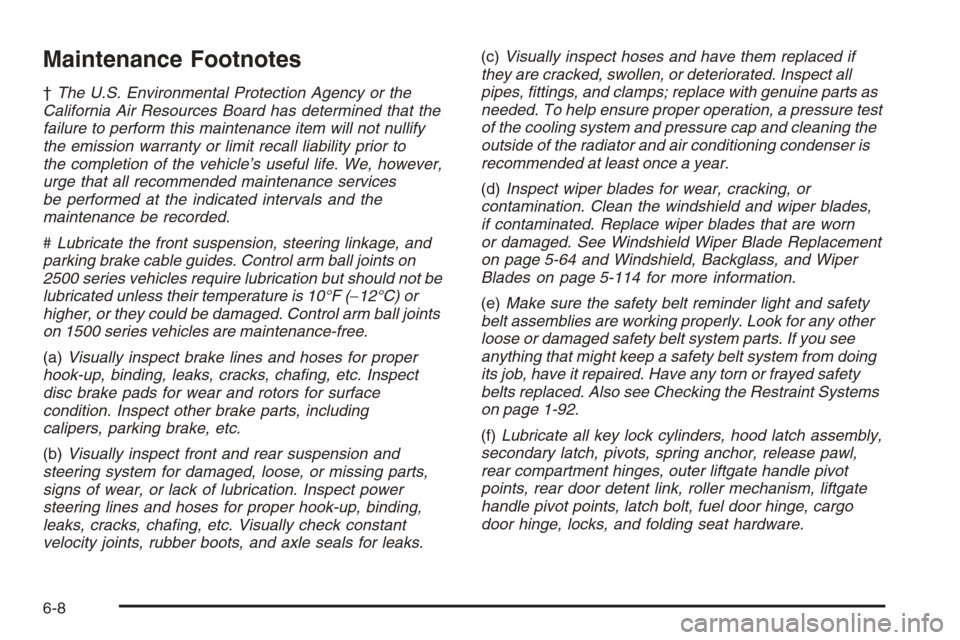
Maintenance Footnotes
†The U.S. Environmental Protection Agency or the
California Air Resources Board has determined that the
failure to perform this maintenance item will not nullify
the emission warranty or limit recall liability prior to
the completion of the vehicle’s useful life. We, however,
urge that all recommended maintenance services
be performed at the indicated intervals and the
maintenance be recorded.
#Lubricate the front suspension, steering linkage, and
parking brake cable guides. Control arm ball joints on
2500 series vehicles require lubrication but should not be
lubricated unless their temperature is 10°F (−12°C) or
higher, or they could be damaged. Control arm ball joints
on 1500 series vehicles are maintenance-free.
(a)Visually inspect brake lines and hoses for proper
hook-up, binding, leaks, cracks, chafing, etc. Inspect
disc brake pads for wear and rotors for surface
condition. Inspect other brake parts, including
calipers, parking brake, etc.
(b)Visually inspect front and rear suspension and
steering system for damaged, loose, or missing parts,
signs of wear, or lack of lubrication. Inspect power
steering lines and hoses for proper hook-up, binding,
leaks, cracks, chafing, etc. Visually check constant
velocity joints, rubber boots, and axle seals for leaks.(c)Visually inspect hoses and have them replaced if
they are cracked, swollen, or deteriorated. Inspect all
pipes, fittings, and clamps; replace with genuine parts as
needed. To help ensure proper operation, a pressure test
of the cooling system and pressure cap and cleaning the
outside of the radiator and air conditioning condenser is
recommended at least once a year.
(d)Inspect wiper blades for wear, cracking, or
contamination. Clean the windshield and wiper blades,
if contaminated. Replace wiper blades that are worn
or damaged. See Windshield Wiper Blade Replacement
on page 5-64 and Windshield, Backglass, and Wiper
Blades on page 5-114 for more information.
(e)Make sure the safety belt reminder light and safety
belt assemblies are working properly. Look for any other
loose or damaged safety belt system parts. If you see
anything that might keep a safety belt system from doing
its job, have it repaired. Have any torn or frayed safety
belts replaced. Also see Checking the Restraint Systems
on page 1-92.
(f)Lubricate all key lock cylinders, hood latch assembly,
secondary latch, pivots, spring anchor, release pawl,
rear compartment hinges, outer liftgate handle pivot
points, rear door detent link, roller mechanism, liftgate
handle pivot points, latch bolt, fuel door hinge, cargo
door hinge, locks, and folding seat hardware.
6-8
Page 495 of 538
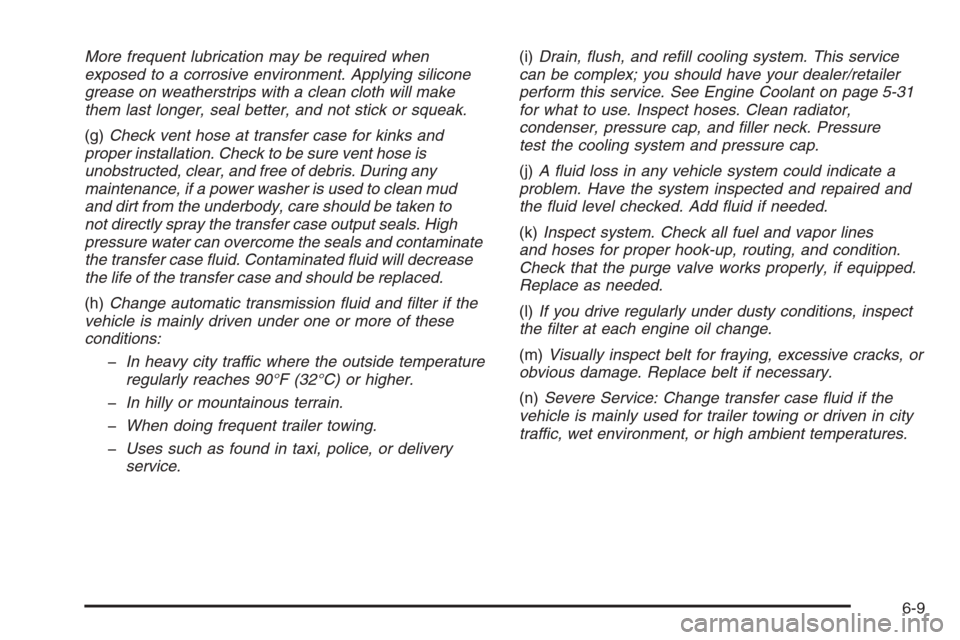
More frequent lubrication may be required when
exposed to a corrosive environment. Applying silicone
grease on weatherstrips with a clean cloth will make
them last longer, seal better, and not stick or squeak.
(g)Check vent hose at transfer case for kinks and
proper installation. Check to be sure vent hose is
unobstructed, clear, and free of debris. During any
maintenance, if a power washer is used to clean mud
and dirt from the underbody, care should be taken to
not directly spray the transfer case output seals. High
pressure water can overcome the seals and contaminate
the transfer case fluid. Contaminated fluid will decrease
the life of the transfer case and should be replaced.
(h)Change automatic transmission fluid and filter if the
vehicle is mainly driven under one or more of these
conditions:
�In heavy city traffic where the outside temperature
regularly reaches 90°F (32°C) or higher.
�In hilly or mountainous terrain.
�When doing frequent trailer towing.
�Uses such as found in taxi, police, or delivery
service.(i)Drain, flush, and refill cooling system. This service
can be complex; you should have your dealer/retailer
perform this service. See Engine Coolant on page 5-31
for what to use. Inspect hoses. Clean radiator,
condenser, pressure cap, and filler neck. Pressure
test the cooling system and pressure cap.
(j)A fluid loss in any vehicle system could indicate a
problem. Have the system inspected and repaired and
the fluid level checked. Add fluid if needed.
(k)Inspect system. Check all fuel and vapor lines
and hoses for proper hook-up, routing, and condition.
Check that the purge valve works properly, if equipped.
Replace as needed.
(l)If you drive regularly under dusty conditions, inspect
the filter at each engine oil change.
(m)Visually inspect belt for fraying, excessive cracks, or
obvious damage. Replace belt if necessary.
(n)Severe Service: Change transfer case fluid if the
vehicle is mainly used for trailer towing or driven in city
traffic, wet environment, or high ambient temperatures.
6-9
Page 502 of 538
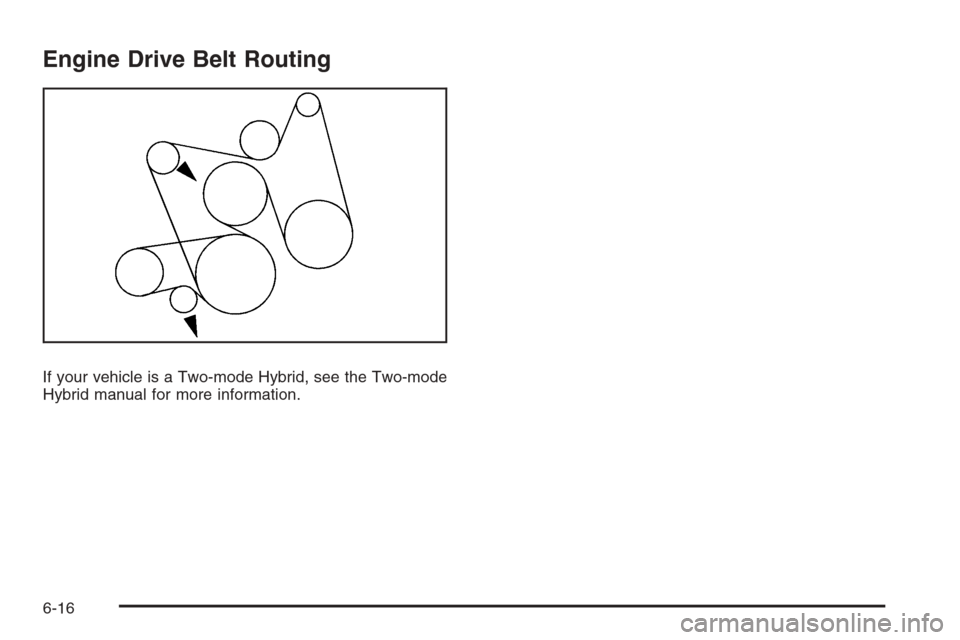
Engine Drive Belt Routing
If your vehicle is a Two-mode Hybrid, see the Two-mode
Hybrid manual for more information.
6-16
Page 523 of 538

Vehicle Data Recording and
Privacy
Your GM vehicle has a number of sophisticated
computers that record information about the vehicle’s
performance and how it is driven. For example,
your vehicle uses computer modules to monitor and
control engine and transmission performance, to monitor
the conditions for airbag deployment and deploy
airbags in a crash and, if so equipped, to provide
antilock braking to help the driver control the vehicle.
These modules may store data to help your
dealer/retailer technician service your vehicle. Some
modules may also store data about how you operate the
vehicle, such as rate of fuel consumption or average
speed. These modules may also retain the owner’s
personal preferences, such as radio pre-sets, seat
positions, and temperature settings.
Event Data Recorders
This vehicle has an Event Data Recorder (EDR). The
main purpose of an EDR is to record, in certain crash or
near crash-like situations, such as an airbag deployment
or hitting a road obstacle, data that will assist in
understanding how a vehicle’s systems performed. The
EDR is designed to record data related to vehicle
dynamics and safety systems for a short period of time,
typically 30 seconds or less. The EDR in this vehicle
is designed to record such data as:
How various systems in your vehicle were operating
Whether or not the driver and passenger safety
belts were buckled/fastened
How far, if at all, the driver was pressing the
accelerator and/or brake pedal
How fast the vehicle was traveling
This data can help provide a better understanding of the
circumstances in which crashes and injuries occur.
Important:EDR data is recorded by your vehicle only
if a non-trivial crash situation occurs; no data is
recorded by the EDR under normal driving conditions
and no personal data (e.g., name, gender, age,
and crash location) is recorded. However, other parties,
such as law enforcement, could combine the EDR
data with the type of personally identifying data routinely
acquired during a crash investigation.
7-17
Page 525 of 538

A
Accessories and Modi�cations............................ 5-3
Accessory Power Outlets.................................3-20
Adding a Snow Plow or Similar Equipment.........4-41
Adding Equipment to Your Airbag-Equipped
Vehicle.......................................................1-90
Additives, Fuel................................................. 5-7
Add-On Electrical Equipment...........................5-119
Adjustable Throttle and Brake Pedal..................2-28
Air Cleaner/Filter, Engine.................................5-22
Air Conditioning......................................3-22, 3-24
Airbag
Passenger Status Indicator...........................3-38
Readiness Light..........................................3-37
Airbag System................................................1-76
Adding Equipment to Your Airbag-Equipped
Vehicle...................................................1-90
How Does an Airbag Restrain?......................1-83
Passenger Sensing System...........................1-85
Servicing Your Airbag-Equipped Vehicle..........1-90
What Makes an Airbag In�ate?......................1-83
What Will You See After an Airbag In�ates?....1-84
When Should an Airbag In�ate?....................1-81
Where Are the Airbags?...............................1-78
Antenna, Rear Side Window...........................3-118
Antenna, XM™ Satellite Radio Antenna System . . . 3-118
Antilock Brake System (ABS)............................. 4-5
Anti-lock Brake, System Warning Light...............3-42Appearance Care
Aluminum or Chrome-Plated Wheels.............5-114
Care of Safety Belts...................................5-112
Chemical Paint Spotting..............................5-116
Cleaning Exterior Lamps/Lenses..................5-113
Fabric/Carpet............................................5-110
Finish Care...............................................5-113
Finish Damage..........................................5-116
Instrument Panel, Vinyl, and Other
Plastic Surfaces.....................................5-111
Interior Cleaning........................................5-109
Leather....................................................5-111
Sheet Metal Damage..................................5-115
Tires........................................................5-115
Underbody Maintenance.............................5-116
Vehicle Care/Appearance Materials...............5-117
Washing Your Vehicle.................................5-112
Weatherstrips............................................5-112
Windshield, Backglass, and Wiper Blades......5-114
Appointments, Scheduling Service.....................7-10
Ashtray.........................................................3-21
Audio System.................................................3-75
Audio Steering Wheel Controls....................3-116
Navigation/Radio System, see
Navigation Manual..................................3-105
Radio Reception........................................3-117
Rear Seat Audio (RSA)...............................3-114
Setting the Clock.........................................3-76
Theft-Deterrent Feature...............................3-116
XM™ Satellite Radio Antenna System...........3-118
1
Page 526 of 538
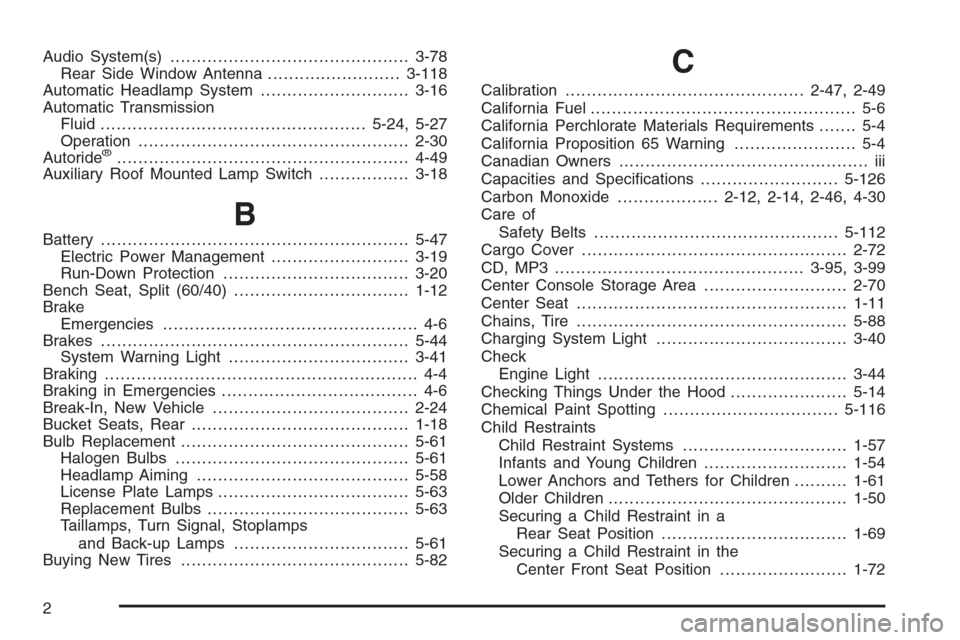
Audio System(s).............................................3-78
Rear Side Window Antenna.........................3-118
Automatic Headlamp System............................3-16
Automatic Transmission
Fluid..................................................5-24, 5-27
Operation...................................................2-30
Autoride
®.......................................................4-49
Auxiliary Roof Mounted Lamp Switch.................3-18
B
Battery..........................................................5-47
Electric Power Management..........................3-19
Run-Down Protection...................................3-20
Bench Seat, Split (60/40).................................1-12
Brake
Emergencies................................................ 4-6
Brakes..........................................................5-44
System Warning Light..................................3-41
Braking........................................................... 4-4
Braking in Emergencies..................................... 4-6
Break-In, New Vehicle.....................................2-24
Bucket Seats, Rear.........................................1-18
Bulb Replacement...........................................5-61
Halogen Bulbs............................................5-61
Headlamp Aiming........................................5-58
License Plate Lamps....................................5-63
Replacement Bulbs......................................5-63
Taillamps, Turn Signal, Stoplamps
and Back-up Lamps.................................5-61
Buying New Tires...........................................5-82
C
Calibration.............................................2-47, 2-49
California Fuel.................................................. 5-6
California Perchlorate Materials Requirements....... 5-4
California Proposition 65 Warning....................... 5-4
Canadian Owners............................................... iii
Capacities and Speci�cations..........................5-126
Carbon Monoxide...................2-12, 2-14, 2-46, 4-30
Care of
Safety Belts..............................................5-112
Cargo Cover..................................................2-72
CD, MP3 ...............................................3-95, 3-99
Center Console Storage Area...........................2-70
Center Seat...................................................1-11
Chains, Tire...................................................5-88
Charging System Light....................................3-40
Check
Engine Light...............................................3-44
Checking Things Under the Hood......................5-14
Chemical Paint Spotting.................................5-116
Child Restraints
Child Restraint Systems...............................1-57
Infants and Young Children...........................1-54
Lower Anchors and Tethers for Children..........1-61
Older Children.............................................1-50
Securing a Child Restraint in a
Rear Seat Position...................................1-69
Securing a Child Restraint in the
Center Front Seat Position........................1-72
2
Page 528 of 538
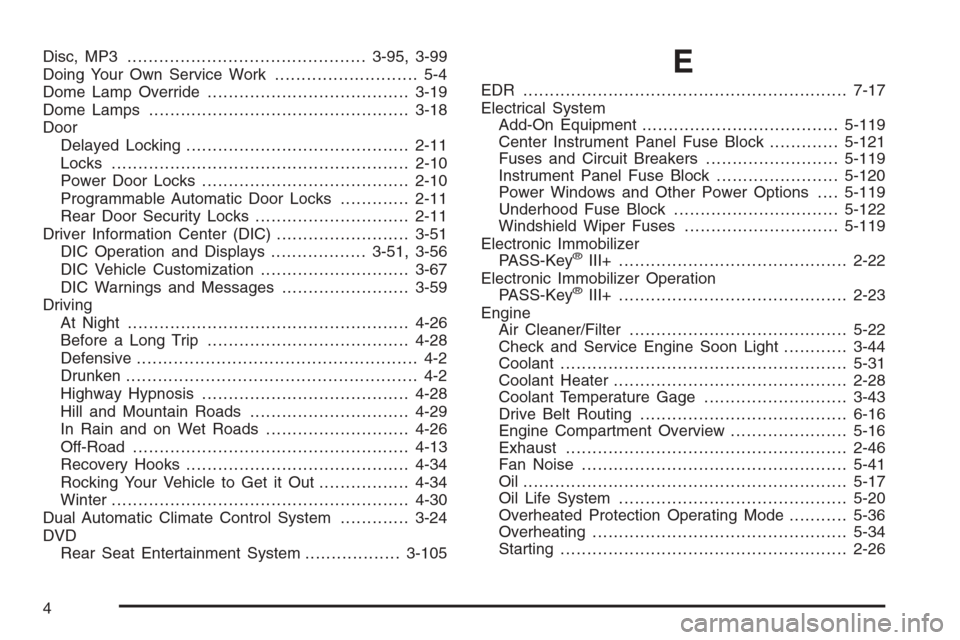
Disc, MP3.............................................3-95, 3-99
Doing Your Own Service Work........................... 5-4
Dome Lamp Override......................................3-19
Dome Lamps .................................................3-18
Door
Delayed Locking..........................................2-11
Locks........................................................2-10
Power Door Locks.......................................2-10
Programmable Automatic Door Locks.............2-11
Rear Door Security Locks.............................2-11
Driver Information Center (DIC).........................3-51
DIC Operation and Displays..................3-51, 3-56
DIC Vehicle Customization............................3-67
DIC Warnings and Messages........................3-59
Driving
At Night.....................................................4-26
Before a Long Trip......................................4-28
Defensive..................................................... 4-2
Drunken....................................................... 4-2
Highway Hypnosis.......................................4-28
Hill and Mountain Roads..............................4-29
In Rain and on Wet Roads...........................4-26
Off-Road ....................................................4-13
Recovery Hooks..........................................4-34
Rocking Your Vehicle to Get it Out.................4-34
Winter........................................................4-30
Dual Automatic Climate Control System.............3-24
DVD
Rear Seat Entertainment System..................3-105E
EDR .............................................................7-17
Electrical System
Add-On Equipment.....................................5-119
Center Instrument Panel Fuse Block.............5-121
Fuses and Circuit Breakers.........................5-119
Instrument Panel Fuse Block.......................5-120
Power Windows and Other Power Options....5-119
Underhood Fuse Block...............................5-122
Windshield Wiper Fuses.............................5-119
Electronic Immobilizer
PASS-Key
®III+...........................................2-22
Electronic Immobilizer Operation
PASS-Key
®III+...........................................2-23
Engine
Air Cleaner/Filter.........................................5-22
Check and Service Engine Soon Light............3-44
Coolant......................................................5-31
Coolant Heater............................................2-28
Coolant Temperature Gage...........................3-43
Drive Belt Routing.......................................6-16
Engine Compartment Overview......................5-16
Exhaust.....................................................2-46
Fan Noise..................................................5-41
Oil .............................................................5-17
Oil Life System...........................................5-20
Overheated Protection Operating Mode...........5-36
Overheating................................................5-34
Starting......................................................2-26
4
Page 529 of 538
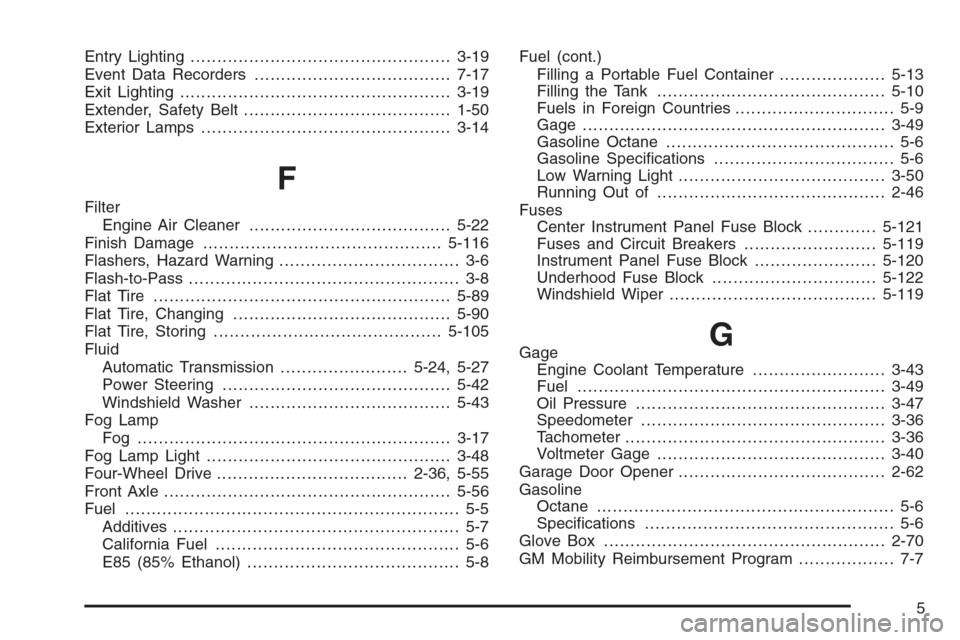
Entry Lighting.................................................3-19
Event Data Recorders.....................................7-17
Exit Lighting...................................................3-19
Extender, Safety Belt.......................................1-50
Exterior Lamps...............................................3-14
F
Filter
Engine Air Cleaner......................................5-22
Finish Damage.............................................5-116
Flashers, Hazard Warning.................................. 3-6
Flash-to-Pass................................................... 3-8
Flat Tire........................................................5-89
Flat Tire, Changing.........................................5-90
Flat Tire, Storing...........................................5-105
Fluid
Automatic Transmission........................5-24, 5-27
Power Steering...........................................5-42
Windshield Washer......................................5-43
Fog Lamp
Fog ...........................................................3-17
Fog Lamp Light..............................................3-48
Four-Wheel Drive....................................2-36, 5-55
Front Axle......................................................5-56
Fuel............................................................... 5-5
Additives...................................................... 5-7
California Fuel.............................................. 5-6
E85 (85% Ethanol)........................................ 5-8Fuel (cont.)
Filling a Portable Fuel Container....................5-13
Filling the Tank...........................................5-10
Fuels in Foreign Countries.............................. 5-9
Gage .........................................................3-49
Gasoline Octane........................................... 5-6
Gasoline Speci�cations.................................. 5-6
Low Warning Light.......................................3-50
Running Out of...........................................2-46
Fuses
Center Instrument Panel Fuse Block.............5-121
Fuses and Circuit Breakers.........................5-119
Instrument Panel Fuse Block.......................5-120
Underhood Fuse Block...............................5-122
Windshield Wiper.......................................5-119
GGage
Engine Coolant Temperature.........................3-43
Fuel..........................................................3-49
Oil Pressure...............................................3-47
Speedometer..............................................3-36
Tachometer.................................................3-36
Voltmeter Gage...........................................3-40
Garage Door Opener.......................................2-62
Gasoline
Octane........................................................ 5-6
Speci�cations............................................... 5-6
Glove Box.....................................................2-70
GM Mobility Reimbursement Program.................. 7-7
5